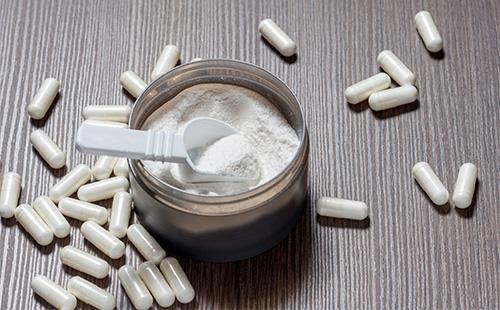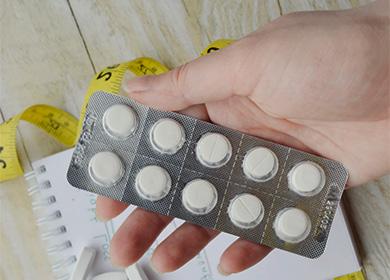The content of the article
Lipoic acid is a vitamin (also called thioctic or vitamin N) that is synthesized in the body. The uniqueness of this compound lies in its ability to penetrate into both the fatty and aqueous media, to concentrate inside the cells, as well as in the extracellular space. The substance readily reacts with free radical ions, providing an antioxidant effect. Moreover, the lipoic acid molecule is able to attract neutralized molecules, restoring the structure and activity of other antioxidants, such as ascorbic acid, tocopherol, retinol. Scientists argue that the antioxidant properties of the drug has no natural analogues.
The mechanism of therapeutic action
The therapeutic significance of lipoic acid is based on only a few actions. All pharmacological effects, in fact, come from them.
Antioxidant
Based on the ability of a molecule to bind free radicals, accelerate the absorption and excretion of harmful organic decay products from the body, and also enter into synergism with other antioxidant molecules. Scientists have proven that lipoic acid helps preserve genetic material by regulating the synthesis of DNA molecules.
Detoxifying
The lipoic acid molecule, which easily reacts, binds heavy metals for their subsequent excretion from the body. It exhibits the same effect with respect to some toxic compounds. For example, with respect to lactic acid, which accumulates in muscle tissue after intense physical exertion.
Insulin-like
Lipoic acid acts as a conductor of glucose molecules into the intracellular space, enhancing and replacing the action of the hormone insulin. This effect is most actively used in diabetes of both types, the first of which is characterized by a lack of insulin. Here, lipoic acid will be its substitute and will help reduce the dose of the hormone injection.In diabetes of the second type, sugar surges are triggered by insensitivity of cells to insulin, therefore lipoic acid will partially fulfill the functions of insulin and transport glucose for its efficient processing by cells.
Energetic
All cells of the human body work on universal “fuel” - ATP. It is produced by cellular mitochondria after the absorption of nutrients from the bloodstream. In metabolic disorders, mitochondrial structures slow down their work, namely: the transformation of fats, proteins and carbohydrates into ATP. As a result, deposits of energy sources arise in reserve, because the cells are simply not able to process everything that enters the body.
In addition, there is an accumulation of under-oxidized products that cannot be used by the body to perform physiological functions. They settle inside the cells, poisoning them, provoking further disturbances, gradually leading to the extinction of functions. Lipoic acid, restoring the function of enzymes, launches a high-quality and complete transformation of nutrients into ATP, providing all body tissues with the energy necessary for functioning.
When Vitamin N is Needed
The synthesis of lipoic acid can interfere with the accumulated during the life of toxins or impaired functioning of cells obtained during aging. This requires an additional supply of lipoic acid from the outside.
Its source can be considered some foods. However, it must be taken into account that the substance is unstable to the action of light, an alkaline medium, and also high temperatures during processing. In addition, various carbohydrate compounds interfere with its absorption. We can say that the products contain lipoic acid in too small quantities, compared with the need for the human body.
Relatively much lipoic acid in:
- beef and offal (liver, kidney, heart);
- mushrooms;
- yeast
- legumes (lentils, beans, peas);
- all types of leafy greens;
- vegetables (carrots, onions, peppers, cabbage);
- wheat and rice cereals;
- dairy products;
- eggs.

Indications
Indications for the use of alpha-lipoic acid come from its beneficial effects and are distinguished by their diversity. As a rule, it is prescribed as a therapy for the mechanism of the development of diseases, because all of them, in fact, begin with metabolic disorders.
Endocrine disorders
Reducing the body's need for insulin, as well as beneficially affecting fat, carbohydrate and protein metabolism, lipoic acid has found a place in the treatment of diabetes and the prevention of its complications. Additional functions of the drug:
- prevents the development of diabetic neuropathy;
- protects against retinopathy;
- normalizes trophism of peripheral tissues;
- maintains the normal state of the vascular walls;
- activates regenerative processes;
- prevents diabetic hepatosis of the liver;
- supports the immune system.
The substance is also used to prevent hypothyroidism in order to prevent the occurrence of fibrous nodes in the glandular parenchyma.
Gastrointestinal diseases
Thioctic acid significantly improves the condition of pancreatic tissue. Therefore, it is prescribed for the treatment of pancreatitis. Doctors also prescribe drugs with lipoic acid for bowel diseases and dysbiosis. However, improper intake of vitamin N can provoke an increase in the acidity of gastric juice and exacerbation of gastritis.
Hepatobiliary system diseases
Lipoic acid is a hepatoprotector.
- Protects liver cells. And also cleans them from the action of toxic substances, therefore, it is used in the treatment of hepatitis of viral, drug and alcoholic origin. Llipoic acid is administered intravenously in acute poisoning. In this case, a noticeable decrease in the negative effect of toxins on the liver structures is observed, and detoxification properties of the liver are improved.
- Used for cirrhosis. In combination with other drugs of thioctic acid, it normalizes metabolic processes, prevents the degeneration of hepatocytes, preventing liver obesity. The ability to restore cell function and neutralize atypical cell structures allows the substance to be used to treat liver steatosis (obesity of liver cells) at any stage.
- Stimulates the production of bile. And regulates its composition. This helps prevent the occurrence of gallstones, and also plays a huge role in eliminating high cholesterol, because it is bile that is the source of high density lipoproteins, which play a role in the disposal of deposits of bad cholesterol.

Other conditions
Metabolic obesity is treated comprehensively, including lipoic acid. Doctors use it to treat diseases of the nervous system:
- neuropathy;
- neurosis;
- Alzheimer's disease;
- with multiple sclerosis.
The ability of thioctic acid to improve the absorption of vitamins has been used in the treatment of severe skin diseases:
The joint helps fight joint problems:
- arthritis;
- arthrosis;
- gout
- osteochondrosis.
Drug Overview
Many drugs contain vitamin N as an active ingredient. It is included in the composition of dietary supplements and nutritional supplements recommended for athletes and losing weight. It is characteristic that the drugs contain the substance under discussion in much larger dosages (from 300 mg and higher), while prophylactic doses (15, 25, 50, 75 mg) are used to make the additives. Overview of popular drugs is in the table.
Table - Drugs with lipoic acid
| Drug name | Manufacturer | Release form | Average price, rubles (as of October 2017) |
|---|---|---|---|
| Berlition | - “Berlin Chemie” | - Film-coated tablets, 300 mg No. 30 | 780 |
| - Concentrate for infusion 25 mg / 1 ml | 560 | ||
| Lipamide | - Pharmstandard | - Film-coated tablets, 25 mg No. 50 | 130 |
| Oktolipen | - Pharmstandard | - Film-coated tablets, 600 mg No. 30 | 700 |
| - Capsules 300 mg No. 30 | 320 | ||
| Thioctacid | - “Viatris” | - Tablets 600 mg No. 30 | 1900 |
| - Tablets 600 mg No. 100 | 2220 | ||
| - Solution for infusion 600 mg No. 5 | 1530 | ||
| Tieolepta | - Canonfarm | - 600 mg coated tablets No. 30 | 660 |
| - Tablets in a coating of 300 mg No. 30 | 320 | ||
| - Solution for infusion 12 mg / 1 ml | 1420 |
Instructions for use of lipoic acid
In order to treat acute and sluggish diseases, doctors prescribe increased doses of lipoic acid - from 300 mg to 600 mg per day. As a rule, therapy begins with intravenous infusions of a daily dose in one procedure.
Injections
The injection form is used during the first two weeks or the first month of treatment, after which the patient is prescribed capsules or tablets with lipoic acid in maintenance dosages.
Ingestion
Thioctic acid tablets must not be crushed, crushed or chewed. The encapsulated forms are also swallowed whole, washed down with a moderate amount of liquid (half a glass of water). Doctors recommend drinking lipoic acid only with clean, still water. Drink alpha-lipoic acid in the morning, on an empty stomach, consuming a daily dose at a time.

Prevention
Prophylactic administration involves the use of three times a day reduced doses of the substance (25-50 mg). Supplements and vitamins, experts recommend drinking after eating. The duration of the preventive course is 30 days. After a month break, resumption of admission is allowed.
For athletes
Athletes are allowed to use increased dosages of vitamin N. For example, up to 200 mg of the substance per day can be used to build muscle or increase stamina. During periods of increased stress and competition, a dose of 300 to 600 mg is permitted.
Possible risks
The use of thioctic (lipoic) acid has some features.
- Intravenous administration. With rapid infusion, the development of headache, convulsions, double vision, a change in color and smell of urine is likely. These symptoms disappear on their own, after a while.
- Security. Periods of pregnancy and lactation are contraindications for taking lipoic acid due to the lack of evidence of safety, although doctors say that the substance is necessary for the body of the expectant mother and baby, so it is introduced into the vitamin complexes for pregnant women ("Alphabet Mom").
- Combination with products.The use of dairy products and whole milk is recommended only four or six hours after taking the drug due to impaired absorption of calcium.
- Combination with alcohol. It is forbidden to use any dose of alcohol in the treatment of lipoic acid due to the risk of developing an overdose of the drug and the harm of alcohol.
- Combination with drugs. It is necessary to take a break (about six hours) between doses of lipoic acid and drugs with metals, since vitamin N interferes with the absorption of the latter.
- Synergistic effect. Vitamin N enhances the action of insulin. Therefore, diabetics should strictly monitor sugar levels during treatment. Increased activity of glucocorticoids has also been observed.
- Side effects. Often they occur only when the dosages are exceeded or alcohol is abused at the same time (nausea, vomiting, heartburn, abdominal pain).
- Withdrawal syndrome. It occurs against the background of prolonged and uncontrolled use of medicinal doses of the drug for weight loss. In this case, the body stops producing the substance on its own.
Lipoic acid refers to those drugs that the doctor needs to prescribe and determine the need for. Despite the naturalness of this compound for the human body, increased doses and violation of the regimen are fraught with unpleasant consequences, as well as complex metabolic disorders. Nevertheless, all warnings are relevant specifically for drugs, prophylactic doses of dietary supplements can be used by patients on their own, according to the instructions.

